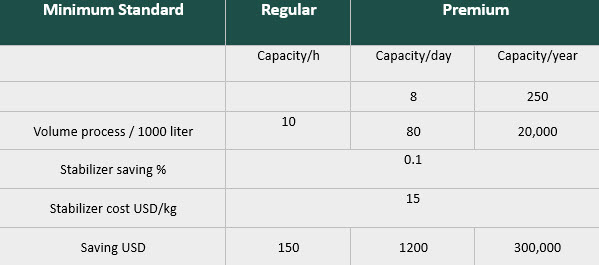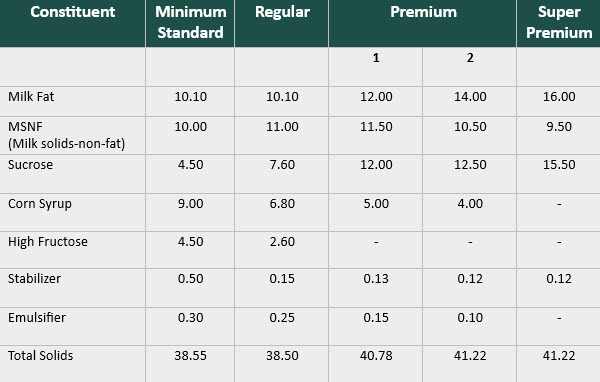Ice cream, once a luxury of European courts, is now enjoyed by people around the world. In this blog post, we will explore the role of innovative ice cream equipment, ingredients and techniques in keeping ice cream at the forefront of innovation.
Understanding the nature of ice cream is essential to succeed. Ice cream consists of ice crystals, air bubbles and a mixture of fat, sugar and flavorings. The ice crystals are formed when the liquid mixture is frozen, giving ice cream its characteristic texture and playing a critical role in determining its quality. The size and number of ice crystals affect the texture and smoothness of the ice cream. Air bubbles are incorporated into the mixture during the churning process, which gives ice cream its light, fluffy texture. Obviously, the proportions of these components vary depending on the type of ice cream that is being produced.
Ice cream is classified into four groups based on ingredients, quality, price, etc. The four categories of ice cream are: minimum standard, regular, premium and super premium.
The composition of the four categories of ice cream is illustrated in Table 1.
To ensure a smooth and creamy texture, as well as an even distribution of ingredients, thorough mixing and homogenization is critical to the ice cream production process. To ensure food safety, the mix is typically pasteurized to eliminate harmful bacteria after the initial mixing and homogenization. This heating process can cause some separation or change in the mix's consistency. Therefore, further mixing is needed to avoid the influence of heat treatment on texture. Additionally, some ice cream recipes may call for the addition of ingredients such as flavors, colors, or mix-ins (e.g., nuts or candies) after the initial mixing stage. These additional ingredients need to be thoroughly incorporated into the mix to ensure even distribution throughout the final product. As such, the process of making ice cream involves repeated mixing and homogenization requiring a reliable end-to-end ice cream solution. Let’s take a closer look of the ice cream process.
- Raw materials
The quality of ice cream raw materials is critical in determining the flavor, texture and safety of the final product. The storage of raw materials for ice cream is also important to maintain quality and safety before these materials are used in the ice cream production process.
Cream and milk should be stored in sealed containers which may prevent contamination and keep it from absorbing any odors or flavors from its surroundings. It’s also important that the storage temperature be at or below 4°C. Ancillary ingredients should be stored in a cool, dry place away from moisture and heat sources.
As illustrated in Table 1, the ingredients of ice cream are milk fat, MSNF, sugar, stabilizer and emulsifiers.
Fat
The fat in ice cream can be dairy fat like cream, butter or vegetable fat. Dairy fat and vegetable fat contribute to varied taste and texture. Dairy fat has a richer, creamier flavor than vegetable fats. The result of using dairy fat is a more luxurious and indulgent ice cream taste. Vegetable fats, such as coconut or palm oil, can add distinct flavor profiles to the ice cream, which is desirable in some recipes. The choice between using dairy fat or vegetable fat in ice cream production depends on the desired taste, texture and nutritional content of the final product, as well as any dietary restrictions or preferences.
Milk solids-non-fat
Milk solids-non-fat (MSNF) includes proteins, lactose, vitamins, and minerals. MSNF plays an important role in ice cream production. First, it contributes to the texture and consistency of ice cream as MSNF helps stabilize the ice cream and give it a smooth, creamy texture. This is particularly important for low-fat or non-fat ice creams where the fat content is reduced or eliminated. Second, MSNF contributes to the nutritional value of ice cream. The protein in MSNF is an important nutrient that helps to build and repair body tissue. Additionally, MSNF provides important minerals such as calcium and phosphorus which are important for strong bones and teeth.
In the ice cream production process, the MSNF content of the milk or cream is often standardized to a specific level to achieve the desired texture and consistency. This is done by adjusting the fat content of the milk or cream. As you can see, MSNF content is an important factor to consider when formulating ice cream recipes to achieve the desired characteristics and nutritional profile.
Sugar
Sugar is added to sweeten ice cream. The low temperature weakens the taste, so sugar is very important to provide a pleasant taste. Also, sugar helps to control the freezing point of the ice cream mix. Sugar molecules interfere with the formation of ice crystals, which can cause ice cream to become hard and icy. By lowering the freezing point of the mix, sugar keeps the ice cream soft and scoopable, even when stored at low temperatures. Additionally, sugar contributes to the texture and mouthfeel of ice cream. Sugar increases the viscosity of the ice cream mix, which makes it smoother and creamier. It also contributes to the formation of air cells during the freezing process, which gives ice cream its characteristic light and fluffy texture. Finally, sugar acts as a preservative in ice cream by inhibiting the growth of bacteria and mold. This helps to extend the shelf life of ice cream and ensure that it stays fresh and safe to consume.
Sugar is super important to the ice cream production process, which is why it is typically added to the mix along with the other ingredients, such as milk, cream and flavorings. The amount of sugar used varies depending on the recipe and desired sweetness level.
Stabilizer
Stabilizers are an important ingredient in ice cream production helping to improve the texture and prevent the formation of ice crystals. Stabilizers work by binding free water molecules in the ice cream mixture, which helps create a smooth and creamy texture. The common types of stabilizers are Carrageenan, to reduce the amount of free water, branched gums including guar gum and gelatin.
Emulsifier
Emulsifiers reduce fat globule coalescence by decreasing the interfacial tensions. They help to create a stable emulsion between the water and fat components of the ice cream mixture, which is essential for achieving a smooth and creamy texture. Monoglycerides and diglycerides are the most commonly used emulsifiers in ice cream production.
- Mixing and Cavitation
The mix is prepared by combining the milk, oil, cream, sugar and any other ingredients in a mixing tank. The ingredients are heated to 50-60°C and stirred until the sugar dissolves and the ingredients are well mixed. Powdered raw materials are then added into a mixing unit with water before going to the mixing tanks. Two or more mixing tanks are needed to maintain a continuous flow.
Mixing is key for functionality in ice cream production. SPX FLOW offers a variety of mixing options.
To be specific, APV® Flex-Mix Instant is a vacuum mixer for recombination, and high shear emulsification can be applied to mixture with a low to medium viscosity. Powdered materials can also be mixed due to the unique high shear mixing. This efficiently removes air during mixing, extending run times and ensuring consistent quality. Moreover, APV® Flex-Mix Instant offers closed, continuous production resulting in higher throughput and reduced dust issues. And, as its name implies, it’s also flexible enough to handle many formulations.
Cavitation is a process of vaporization, bubble generation and bubble implosion which occurs in a flowing liquid. Cavitation increases the surface area of raw material particles leading to more intimate mixing. The APV® Cavitator has various functions from instant hydration e.g., high protein cold mixing and smoothening to scale-free heating and gas dosing / dispersion.
The APV® Cavitator is a next generation mixing, dispersion and scale–free heating technology. The heart of the technology is a specialized rotor with holes. The spinning action generates hydrodynamic cavitation within the holes away from the metal surfaces.
The APV® Cavitator is a patented technology based on “Controlled Cavitation” characterized by no damage. Its powerful forces produce results that far exceed those of conventional technology. The APV® Cavitator mixes gases and liquids, liquids and liquids, and solids and liquids at the microscopic level which increases the mass transfer rate and accelerates processing. It is excellent for hydration and emulsification, mixing and dispersion of thick liquids, shear sensitive components or products and further mixing of particulates.
The APV® Cavitator enhances productivity and product quality while achieving the 100 % utilization of added ingredients and reducing hydration and aging time caused by instant hydration of proteins. It causes an effect of pre-emulsification giving rise to a steadier work of the homogenizer with less down time. APV® Cavitator reduces the amount of stabilizer from 0.3% to 0.2% which contributes to a considerable cost saving. For example, in a factory with 8 hours of work per day and 250 production days per year, the cost savings are calculated in Table 2.
Table 2 Cost saving of APV® Cavitator

- Pasteurization and Homogenization
After thorough mixing, the ice cream mix is then pumped into a plate heat exchanger and preheated to 73-75°C prior to the homogenization at 140-200 bars. Homogenization helps to break down the fat globules into smaller particles that are evenly distributed throughout the mix. This process helps prevent the formation of large fat clusters in the ice cream, which can result in a grainy texture or uneven distribution of fat in the product. Then the mixture is pasteurized in a plate heat exchanger at 83-85°C for 15 seconds. The mix is subsequently cooled to 5°C and transferred to the ageing tank. SPX FLOW provides APV® plate heat exchangers and APV® homogenizers for this.
- Ageing
The ice cream mix should be aged for a minimum of 4 hours at 2-5°C under gentle vibration. Ageing, also known as maturation, is an important step in the ice cream production process that involves holding the mix at a low temperature for a period before it is frozen and churned into ice cream. The main purpose of ageing is to allow the stabilizers and emulsifiers in the mix to hydrate fully and create a smooth and creamy texture in the final product. This allows the fat to crystallize, which helps to create a stable emulsion and prevent ice crystals from forming during freezing and storage. Ageing can also help improve the flavor of the ice cream by allowing the ingredients to blend and develop more fully. This is particularly important for recipes that use natural flavorings, as the aging process can help to bring out the full flavor of the ingredients.
- Flavor vat system
A flavor vat system prior to the continuous freezing allows for precise control of the amount and type of flavorings added to the ice cream mix. SPX FLOW provides APV® dosing vat system for this.
- Continuous freezing
In continuous freezing, the ice cream mix is rapidly frozen using a refrigerant, such as ammonia or Freon, which is circulated through a series of evaporator tubes inside the freezer. The two functions of continuous freezing:
- To control the amount and distribution of air into the mix
- To freeze the water into small ice crystals
In the continuous freezer, air is frozen to -3 to -6°C and whipped into the mix of raw materials.
Additives such as ripples, fruit and chocolate can be added to the ice cream after the continuous freezing.
SPX FLOW partners with Ice-Group Poland for continuous freezers and hardening tunnel.
- Packaging
Ice cream packaging is designed to protect the product from external factors that affect quality like moisture, light, heat and odors. Packaging also helps keep the ice cream at the desired temperature and texture during transportation and storage.
The packaging process typically involves the following steps:
- Filling: The ice cream is dispensed into the packaging material, such as a carton, tub, cup or cone. The amount of ice cream in each package is carefully measured to ensure consistent portion sizes.
- Sealing: The packaging is sealed to prevent air and moisture from entering and to maintain the freshness of the ice cream. Different sealing methods can be used, such as heat sealing, adhesive sealing or mechanical sealing.
- Labeling: The packaging is labeled with branding, nutritional information and other required information, such as the manufacturing date and expiration date.
- Quality control: The packaging is inspected to ensure it meets quality standards, and that the product is properly sealed and labeled.
Once the ice cream is packaged it is transported and stored under controlled conditions to maintain quality and safety. The packaging may include features such as insulation or refrigeration to help keep the ice cream at the desired temperature during transportation and storage.
SPX FLOW partners with Ice-Group Poland for packing lines.
Just as ice cream has changed over the centuries, taste and texture are no longer the only things consumers look for in ice cream. As such, the development of healthy alternatives and the sustainability of products is receiving more and more attention.
Partner with SPX FLOW, a global leader in ice cream production solutions to elevate your ice cream manufacturing capabilities. We offer full control of product streams which is critical throughout the process. From pumps and valves to homogenizers, heat exchangers and more, we are perfectly positioned to help you reach your goals with ice cream. Moreover, at our Innovation Centers, we offer comprehensive support for ice cream production, providing the venue, equipment and expertise needed to develop and manufacture various ice cream applications. Our centers also assist in analyzing market conditions and crafting sensory profiles to enhance taste and mouthfeel, optimize protein content, and refine end products for market success.
For each step, the products SPX FLOW offers are listed below.




